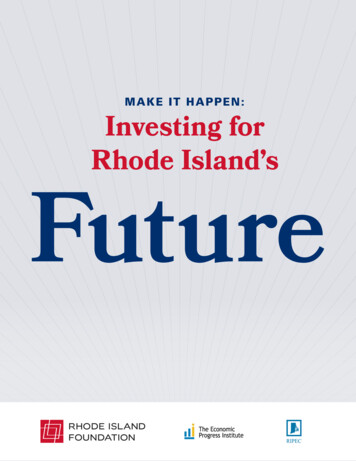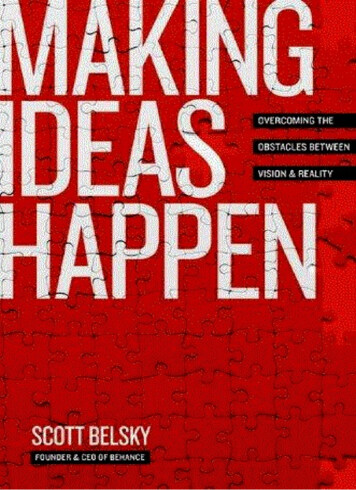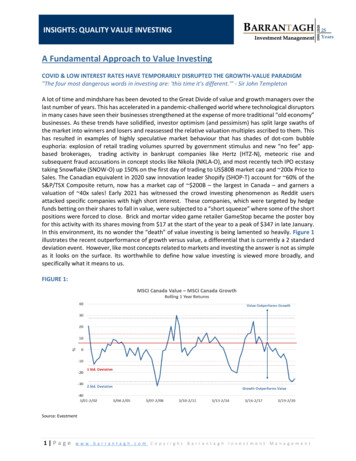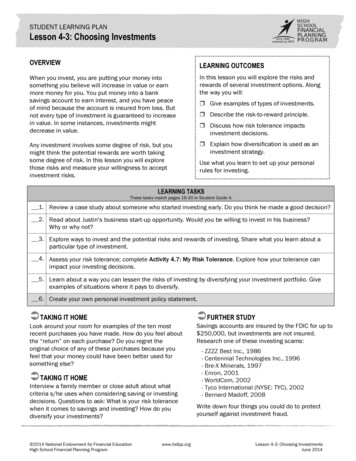
Transcription
M A K E I T H A PPE N :Investing forRhode Island’s
Guiding PrinciplesRecommended investments will 1.2.3.4.2Equity:Address the root causes and conditions of systemicinequalities based on race, gender, disability, economicstatus, and other historically marginalized or oppressedcommunities which predated and were exacerbated by theCOVID-19 pandemic.Sustainability:Deliver enduring change and solutions that enhance theresilience of impacted communities.Impact:Transform economic opportunities and quality of life, andbuild community assets for impacted communities for theshort and long term.Process:Reflect both broad input from impacted communities andpublic stakeholders, as well as solid data and research.
MAKING IT HAPPENInvesting forRhode Island’s FutureExecutive Summary4Steering Committee9Background and Process10American Rescue Plan Act Funds for Rhode Island15Investment Recommendations18HousingBehavioral Health1925Workforce DevelopmentSmall Business AssistanceNeighborhood TrustsImmediate Relief32374243Implementation, Capacity, Accountability, and Oversight46Appendix48Stakeholder Organizations and Individuals Interviewed48Summary of Ideas Submitted52Focus Group FindingsSummary: Community Visioning Sessions82983
Executive SummaryMake it Happen: Investing for Rhode Island’sFuture is a Rhode Island Foundation-led initiativeto develop recommendations for state leaders toconsider as they decide how to spend 1.1 billion infederal American Rescue Plan Act funding.During early Spring 2021, the Foundation contracted with the Economic ProgressInstitute (EPI) and the Rhode Island Public Expenditure Council (RIPEC) to staff theinitiative and convened a 15-member Steering Committee to consider rigorous policyanalysis, public, and stakeholder input to develop a set of spending recommendations that,if adopted, have the potential to significantly improve the lives of Rhode Islanders. TheCommittee, EPI, and RIPEC were focused on the recommendations that follow addressingneeds that pre-existed COVID-19 and were exacerbated by the pandemic. In addition, thework was informed by a set of Guiding Princples developed cooperatively by the SteeringCommittee (see page 2).A vigorous community engagement process spanned several months and includedelectronic submissions from individuals and groups, focus groups with populationshard-hit by COVID, community visioning sessions hosted by local nonprofits, and keystakeholder interviews (see Appendix for details). The Steering Committee considered thebreadth of the subject areas in the recommendations and while agreeing on the areas inthe recommendations below, acknowledged the importance of other topics—for example,education, broadband and digital access, and climate change. These are topics for whichfunding is available or is likely to be available through other federal investments.Throughout 15 meetings, the Steering Committee, which broadly represented ourdiverse community, was provided with a large quantity of data and research, including:guidance from federal and state officials regarding American Rescue Plan Act (ARPA)fund disbursement, the ways in which other states proposed using ARPA funds, needsassessments in requested topic areas, and program and policy analyses. During thisprocess, the Steering Committee was steadfast in its commitment to transformationalchange that will benefit those communities and underserved populations that have beendisproportionately impacted by COVID-19.4
This initiative does not examine or make recommendations for uses of other verysignificant ARPA earmarked funds, such as those for local cities and towns ( 542M),K-12 education ( 400M), higher education ( 168M), or the capital project fund ( 113M).It also recognizes that further federal programs are contemplated that would meetadditional needs, also not addressed in this report.However, the Steering Committee noted the real need for collaboration, coordination,and oversight in the use of the funds between municipalities and the state to achievethe best outcomes for their residents. Similarly, while each recommendation areaaddresses an individual component of need, the Committee emphasized that theseareas are interrelated. The Committee urges that in making investments of ARPA fundsattention must be paid to how funding for the different areas can be used in communitiesmost adversely impacted by the COVID-19 pandemic, and with robust communityengagement. The Committee also noted that residents should be able to easily accessand receive assistance in obtaining available services that meet their needs.This is an historic opportunity to address and counter the disparate public health andeconomic impacts of the coronavirus pandemic, which reflect long-standing inequitiesbased on systemic racism, gender, and disability. And, to ensure that investment of thesefunds supports a genuine recovery that is broad and inclusive, efforts to allocate ARPAfunds need to be transparent and accountable to all Rhode Islanders.This initiative was committed to a rigorous, comprehensive, and inclusive process withthe belief that those populations which were impacted the most by the pandemic shouldbenefit the most from these resources.The recommendations that follow, totalling 1.065 billion, meet the requirements ofUnited States Department of the Treasury’s (Treasury) Interim Final Rule. By investingin the areas suggested below, Rhode Island will be addressing the needs of residentsdisproportionately impacted by COVID-19. These proposals target low-income residentsand communities of color, and directly address many needs. Collectively, these “bigideas,” if implemented, could be major vehicles for building wealth and economicopportunity to ensure a more equitable Rhode Island.5
Executive SummaryHousing 405 millionThe goals and recommendations that followaim to address the decades-long acuteshortage of housing in Rhode Island, especiallyfor those with low to moderate income.GOALS: Provide at least 5,150 units ofaffordable housing to Rhode Islandersby investing in affordable rental housing,permanent supportive housing, andhomeownership opportunities; remediatelead paint for at least 2,850 units; andrenovate and/or repair code violations for atleast 4,000 homes.RECOMMENDATION 1: Invest 200 millionfor affordable rental housing production andpreservation.RECOMMENDATION 2: Invest 50 millionto build 500 units of permanent supportivehousing and provide temporary housing fortargeted populations.RECOMMENDATION 3: Invest 50 millionto expand first-time home buyer programs toincrease home ownership opportunities forBlack, Indigenous, and People of Color (BIPOC)populations and/or in areas disproportionatelyimpacted by COVID-19.RECOMMENDATION 4: Invest 100 millionfor healthy homes repairs, including theremediation of lead paint and assistanceto low-income homeowners and qualifyinglandlords for renovations to substandard unitsfor code compliance.6RECOMMENDATION 5: Invest 5 millionto develop a strategic plan and to improvecapacity and expedite processing of housingprojects that are accessing ARPA funds.Behavioral Health 255 millionThe goals and recommendations that followattempt to address the well-documented,ongoing, epidemic among those battlingmental health and substance abuse challenges.GOALS: Decrease statewide emergencydepartment visits by both children and adultsfor acute behavioral health crises by 20%each; decrease the number of unintentionalopioid overdoses and suicides by 15% each;increase the number of Rhode Island licensedoutpatient mental health counselors, socialworkers, psychologists, and psychiatrists toreach New England’s behavioral healthcareoccupational median.RECOMMENDATION 1: Invest 170 million tobuild new facilities and renovate and upgradeexisting facilities to expand and improveservices and treatments across the behavioralhealth continuum of care.RECOMMENDATION 2: Invest 50 million intechnology infrastructure, including electronicmedical records and other non-facilityinfrastructure, including one-time investmentsin mobile response and stabilization services,and technology that could increase theavailability and access to telemedicine.
RECOMMENDATION 3: Invest 30 millionto increase provider capacity througha loan forgiveness program, as well asstipends/bonuses, to recruit and retainbehavioral health professionals. Theprogram should target BIPOC populationsto build a culturally and linguisticallydiverse behavioral health workforce.RECOMMENDATION 4: Invest 5 millionto complete a strategic plan for a behavioralhealth system of care for adults and children.Workforce Development 205 millionThe goals and recommendations that followaim to address the fact that businesses ofall sizes in Rhode Island are facing workershortages, while many residents remainunemployed or underemployed andencountering barriers to employment, suchas lack of affordable childcare.GOALS: Provide 15,000 Rhode Islanderswith high-quality jobs through robusttraining, adult education, workforce skillsservices, and the elimination of barriers toemployment.RECOMMENDATION 1: Invest 150million in high quality “earn and learn” jobtraining programs that lead to a promotion,certificate, academic credential, and/orhigher salary.RECOMMENDATION 3: Invest 15 millionfor one year to continue and expandthe RI Reconnect initiative that providesassistance to individuals to mitigatebarriers to participation in a job training oremployment opportunity.RECOMMENDATION 4: Invest 10 million inIT data structure improvements to the state’slongitudinal data system and support a planfor long-term sustainability of that system.Small Business Assistance 100 millionThe goals and recommendations that followrecognize that as the backbone of RhodeIsland’s economy, small businesses requiresignificant additional support to sustain andgrow their businesses.GOALS: Provide significant financialassistance to at least 2,250 small businesses,targeted to minority-owned businesses,through forgivable loans, low-interest loans,and grants.RECOMMENDATION 1: Invest 50 millionin Rhode Island small businesses andcooperatives through forgivable loans.RECOMMENDATION 2: Invest 35 millionto provide technical assistance to smallbusinesses by awarding one-time grantsfor business services through a newlyestablished business resource network.RECOMMENDATION 2: Invest 30 million inhigh quality and accessible adult education/foundational workforce skills includingEnglish language, literacy, and digital skills.7
Executive SummaryRECOMMENDATION 3: Invest 10 millionto create a new Community DevelopmentFinancial Institution (CDFI) or expand capacityof one or more existing CDFIs to providefinancing for projects in distressed andunderserved neighborhoods in Rhode Island.RECOMMENDATION 4: Invest 5 millionto establish a loan program for certifiedMinority Business Enterprises (MBEs).Neighborhood Trusts 50 millionThe recommendation that follows suggeststhat investments, directed by residents inplaces whose populations and communitieshave been impacted most by the pandemicmay prove to make a significant, innovativeimpact for those living in a QualifiedCensus Tract.RECOMMENDATION: Invest 50 millionfor the creation of neighborhood trusts inQualified Census Tracts.Immediate Relief 50 millionThe recommendation that follows recognizesthat there is a continued short-term need tosupport those most impacted by COVID-19.RECOMMENDATION: Invest 50 million inRhode Island nonprofit organizations toprovide immediate relief to residents sufferingfrom behavioral health disorders, economic,food and housing insecurity, lack of affordablechildcare, and domestic violence, exacerbatedby the COVID-19 pandemic.8Implementation, Capacity,Accountibility & OversightRECOMMENDATION: We recommendthat an office be established within theGovernor’s Office and reporting directly tothe Governor with the authority to overseethe recommended spending of ARPA fundspursuant to clear goals, performance metrics,and transparency. The critical responsibilitiesof this office would include ensuring thatfunds are expeditiously used and oversightof expenditures. This office would needadditional staffing for the expenditure periodand would coordinate with legislative inputand oversight.Each recommendation area addresses anindividual component of need, but theneeds of those individuals and communitiesmost adversely impacted by the COVID-19pandemic are interconnected. It is important,then, that these recommendations beviewed as, and implemented through, aholistic and community-driven approachprioritizing those communities mostimpacted by the pandemic.
Steering CommitteeNeil D. Steinberg, Chair, President and CEO of Rhode Island FoundationMarcela Betancur, Executive Director of the Latino Policy InstituteJessica David, Founder and Principal at Good Worth Working ForDitra Edwards, Executive Director of SISTA FireJohn Friedman, Professor of Economics and International and Political Affairs atBrown UniversityJohn Galvin, President and CEO of AAA NortheastMarie Ganim, Former Rhode Island Health Insurance Commissioner and formerRhode Island Senate Policy DirectorRoss Gittell, President of Bryant UniversityRajiv Kumar, Technology entrepreneur and Founder of ShapeUpTony Maione, Former President and CEO of the United Way of Rhode IslandAnna Cano Morales, Associate Vice President for Diversity, Equity and Inclusionat Rhode Island CollegeNina Pande, Executive Director of Skills for Rhode Island’s FutureMegan Ranney, Professor of Emergency Medicine and Associate Dean of theSchool of Public Health at Brown UniversityNic Retsinas, Director Emeritus, Harvard Joint Centers for Housing StudiesDon Stanford, Adjunct Professor of Computer Science at Brown University andformer Chief Technology Officer at GTECHEdi Tebaldi, Professor of Economics and Executive Director of InstitutionalEffectiveness and Strategy at Bryant University9
Background and ProcessIn April 2021, prompted by passage of theAmerican Rescue Plan Act, the Rhode IslandFoundation initiated Make It Happen: Investingfor Rhode Island’s Future.The initiative’s goal, working with a diverse, experienced, 15-member Steeringcommittee, the Rhode Island Public Expenditure Council (RIPEC)1, and theEconomic Progress Institute (EPI)2, was to pull together three to five transformativerecommendations to share with the public, and state leaders, as they decide howto spend the 1.1 billion in ARPA funds that the state is receiving from the federalgovernment. The Governor, Speaker of the House of Representatives, and President ofthe Senate were also briefed on this undertaking.At the outset of this process, the Foundation engaged EPI and the RIPEC to leadstakeholder conversations, provide policy analysis, and help to craft recommendationsfor use of the funds. And, we worked together to appoint a 15-member SteeringCommittee to guide the work (see page 9). The Steering Committee was comprisedof members of the community representing diverse backgrounds, including medicaldoctors, academics, nonprofit leaders, community advocates, local business owners,and policy experts.The Steering Committee has been working together for many months, first with a focuson establishing clear guiding principles for our collective effort that are consistent withthe stated intent of this once-in-a-generation federal funding. The guiding principles arefocused on equity, sustainability, impact, and process (see page 2).101The Rhode Island Public Expenditure Council is a nonpartisan and nonprofit public policy research organizationdedicated to advancing fiscally responsible government, competitive tax policies, and economic opportunitiesfor all in Rhode Island.2The Economic Progress Institute – formerly The Poverty Institute – is a nonpartisan research and policyorganization dedicated to improving the economic well-being of low- and modest-income Rhode Islanders.
In addition to the guiding principles, the Steering Committee and our project teamagreed that recommendations would be informed by a number of things: Significant public and stakeholder input Rigorous policy analysis by the teams from RIPEC and EPI Dialogue among Steering Committee members at their regularmeetings from April through October, 2021As stated, robust community engagement was a primary focus of this initiative. Atits launch, the Rhode Island Foundation made a general call for ideas that could besubmitted via email. In early summer, the Foundation provided an “idea generationtoolkit” that was available on the Foundation’s website and encouraged communitygroups and individuals to independently convene conversations designed to generateideas. The summaries of these conversations were submitted to the Foundation usingthe toolkit feedback template. The Rhode Island Foundation received nearly 410investment ideas - approximately 185 ideas via email submission and roughly 225 ideasvia online toolkit submission.3In addition to the submissions described, EPI and RIPEC conducted over 60 keystakeholder interviews, hearing from a diverse array of nearly 150 people. A full list ofthose interviewed can be found on page 48 of the Appendix. The stakeholder groupsranged across geographic regions, the political spectrum, and areas of expertise. Theyincluded community-based organizations, peer support groups, nonprofits, for-profits,trade associations, higher education institutions, small businesses, advocacy groups, andstate agencies. EPI and RIPEC provided feedback and ideas from these groups to theSteering Committee.Global Strategy Group, acting on behalf of the Rhode Island Foundation, convened fiveanonymous focus groups to hear directly from approximately 30 community memberswho identified as being a part of communities hardest hit by COVID, including Hispanicresidents, Black residents, disabled residents, multiracial women, and White seniors.Those who participated had less than a college education and a combined householdincome of less than 75,000. Participants provided ideas regarding what the state coulddo to improve their quality of life.3Ideas submitted via the online toolkit are listed in the appendix beginning on page 52. Ideas submitted via emailhave been shared with the Steering Committee but are not included in the contents of this document.11
Background and ProcessAcross all five conversations, healthcare and more affordable housing options werethe two areas that participants agreed were most important to a good quality of life.Economic development and job opportunities were also discussed but were less urgentthan affordable housing and healthcare. The same was true for investing in technologyand environmental programs—these topics were deemed important, but less urgent.Focus group members who identified as seniors and/or having a disability expressedsignificant frustration with the lack of reliable transportation across the state; for thesegroups in particular, transportation was deemed as very important to quality of life.Overall, focus group participants keyed in on six areas for investment—aimed atimproving quality of life: Advocacy programs in both primary and behavioral health More subsidized housing Increased diversity and language capacity among health andbehavioral healthcare providers Job training opportunities specifically designed for people withdisabilities Investment in small businesses for people who would like to work forthemselves Increased financial assistance to help with the high cost of healthcareand prescriptionsA slide deck detailing the focus group findings can be found on page 82 of the Appendix.Six local nonprofit organizations (Community Action Program of Providence County, Dr.Martin Luther King, Jr. Community Center, Jonnycake Center for Hope, Progreso Latino,United Way of Rhode Island, and the West Bay Community Action Program) hosted 11community visioning sessions throughout the state. Approximately 125 Rhode Islandersparticipated. The conversations took place in late summer and were an opportunity forparticipants to dig in to topics identified as priority areas for investment by focus groupparticipants, through the idea submissions received by the Foundation as part of thisprocess, via key stakeholder interviews, and as part of the Committee’s own deliberations.12
Across these conversations, it was clear that participants were affected and challengedby many interconnected factors; however, the most frequently discussed topics werehousing, COVID-19, education, health and mental health. Business, jobs, and theeconomy were also frequently discussed across conversations. There was generalagreement that the challenges community members face often seem—and feel—intractable, and there was additional agreement that navigating systems should not be sochallenging, particularly for those in need.Regarding housing, there was consistent dialogue about the lack of, or subpar conditionof, housing stock, lack of affordable housing and transitional housing. Additionalconversation focused on prioritizing those most in need; and there was consistentdialogue regarding wrapping services around accessible and affordable housing—creating opportunities for healthcare, behavioral healthcare, educational and workforcedevelopment opportunities, affordable childcare, and more, where people live.Participants’ discussions regarding COVID-19 centered around the pandemic’s impact onpeople’s daily lives and challenges exacerbated by the crisis.There was also significant conversation about education and workforce development,with participants focused on the need to prepare students to enter the workforce andsucceed, the need to make good quality education more accessible for all traditionaland non-traditional students, and to ensure that educators are culturally competent andconnected to the community of students they teach.Health and behavioral health were also frequently discussed topics. There wassignificant conversation about intergenerational trauma, access to services and providersthat are reflective of the community, and discussion regarding ways to coordinate acrossthe nonprofit sector to help folks navigate and learn about the health system.Rhode Islanders who engaged in the community visioning sessions also spoke at lengthabout business, jobs, and the economy. Specifically, participants discussed barriers toemployment and difficulty accessing living wage jobs or advancing in a career. Therewas significant conversation around the importance of access to reliable transportationand affordable childcare, as well as safe affordable housing. Discussion regardingsmall business and entrepreneurship focused on access to education and informationregarding how to start and manage a business, and support for small local businesses.A slide deck detailing the input received can be found on page 98 of the Appendix.13
Background and ProcessThroughout 15 meetings, the Steering Committee was provided with robust data andresearch including: guidance from federal and state officials regarding ARPA funddisbursement, information regarding the ways in which other states proposed usingARPA funds, needs assessments in requested topic areas, and programs and policiesthat could address issues and specifically target those communities and underservedpopulations that were disproportionately impacted by COVID-19. RIPEC and EPIprovided the Steering Committee with rigorous policy analysis. With problems clearlyidentified, staff examined current programs and gaps to assess additional programmaticand financial needs. Finally, RIPEC and EPI researched national best practices, modelprograms, and innovative approaches to address the pressing needs in focused areas.These ideas were presented to the Steering Committee for discussion and debate. TheCommittee engaged in thoughtful discussion and reflection around each identified areaas they contemplated proposals.The group has also kept close watch on the guidance from federal and state officialsregarding the fact that these funds should be spent in ways that support those mostimpacted by COVID-19, particularly in historically marginalized communities. We seethis as an incredible opportunity for real investment that pushes us closer to equity—investment in people and places that need it the most.The emphasis of our work has been to recommend sustainable, transformativeinvestments to be made over the three years allowed under ARPA. We did not focusprimarily on funding existing programs or state-level initiatives, nor was the workintended to inform how ARPA funding that cities and towns, or the state, will receive forspecific areas —such as education or rent relief—will be allocated. That said, our hopeis that the recommendations we make in this report will complement and, whereverpossible, be coordinated with other local and state-level ARPA-funded investments.In fact, the recommendations contained in this report should not be viewed andimplemented in silos but rather through a holistic and community-driven approach.In the end, after revising and revamping promising strategies, the Steering Committeedecided on recommended investment areas and formulated and finalized proposals.Thereafter, they determined the suggested allocation of ARPA funds - 1.065 billion ofthe 1.1 billion - across broad areas of focus and offered specific spending areas withineach. Throughout these meetings and conversations, the Steering Committee wassteadfast in their commitment to transformational change.Developing ideas regarding how best to leverage the opportunities these dollars presentis something we have taken very seriously. Thanks to the support of the SteeringCommittee, many engaged community members, and our partners across sectors, thisprocess has been robust, rigorous, inclusive, and unique—by design.14
American Rescue Plan ActFunds for Rhode IslandThe American Rescue Plan Act (ARPA), signedinto law on March 11, 2021, provides Rhode Islandwith over 2.5 billion in relief funding, on top ofthe relief funding from the Coronavirus Aid, Relief,and Economic Security (CARES) Act and otherfederal sources, such as the Federal EmergencyManagement Agency (FEMA).The ARPA relief funds come in two buckets: at least 772 million in targeted aid and 1.74 billion in more flexible aid. The targeted aid supports pandemic response in suchareas as education, childcare, public health, and housing and rental assistance. Themore flexible aid is called State and Local Federal Relief Funds (FRF) and includes 542million for Rhode Island’s local governments and 1.2 billion in state funding. Of thestate funds, 113 million is designated for capital projects. This report addresses the useof 1.1 billion state funding, exclusive of capital projects funds.The ARPA funds are distributed in two ways: some funds go directly from thefederal government to the recipient entities, while most funds flow through the state.Approximately 273 million from the local FRF goes directly to Rhode Island’s sixlargest municipalities, and 168 million of targeted funds go directly to public andprivate nonprofit colleges and universities. The vast majority of relief funds, bothtargeted and flexible, flow through the state. The targeted aid, such as rental assistanceor education funding for primary and secondary schools, is passed through the stateto the recipient entities without any allocation decisions on the part of the Governor orGeneral Assembly. So too is the remainder of the local FRF; the state transfers funds tothe smaller municipalities, and because Rhode Island possesses no county governancestructure, the FRF for counties are divided proportionally and transferred to allmunicipalities within those counties.15
American Rescue Plan Act Funds for Rhode IslandFunds must be obligated by December 31, 20244 and spent by December 31, 2026.5 Fundsnot obligated or spent by these deadlines must be returned to the federal government. TheUnited States Department of Treasury has released draft guidance and an Interim Final Ruleas to how states can and cannot use the funds, impacting the 1.1 billion that Rhode Island isreceiving. Although quite flexible, Treasury has set some limits. Funding cannot be used to: payinto pension or rainy-day funds, service debt, cover legal settlements, spend on infrastructureprojects (except for water, sewer, and broadband), or offset recent tax cuts.Treasury has specified five areas for appropriate spending: to pay for the public health responseto the pandemic, to respond to damaging economic impacts of the pandemic (including aid tohouseholds, small businesses, nonprofits and industries), to provide premium pay for essentialworkers, to replace lost public sector revenue, and to support water, sewer, and broadbandinfrastructure projects.Furthermore, the Treasury guidance and the Interim Final Rule emphasize the criticalimportance of addressing and countering the disparate public health and economic impacts ofthe coronavirus pandemic, the fact that some communities—particularly people of color—havefared much worse than others during the pandemic, and that a genuine recovery must be broadand inclusive.The recommendations contained in this report meet the requirements of Treasury’s InterimFinal Rule. By investing in housing, behavioral health, workforce development, small business,and Neighborhood Trusts, RI will be addressing the needs of residents disproportionatelyimpacted by COVID-19. These proposals target low-income and BIPOC households andaddress their needs through high-quality workforce development training and foundationalskills programs, home and small business ownership opportunities, and increased access tobehavioral health treatments and services. Operating in Qualified Census Tracts, NeighborhoodTrusts also fulfill the ARPA requirements. Collectively, these “big ideas,” if implemented, couldbe major vehicles for building wealth and economi
Make it Happen: Investing for Rhode Island’s Future is a Rhode Island Foundation-led initiative to develop recommendations for state leaders to consider as they decide how to spend 1.1 billion in federal American Rescue Plan Act funding. During early Spring 2










